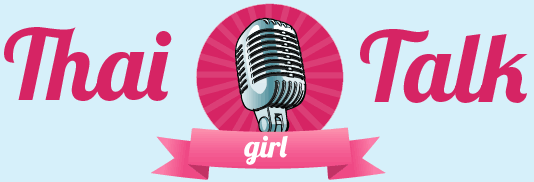
Learn a few ways to say “Hello” and “Goodbye” in Thai as well as how to wai or greet a Thai person. We also talk about the common reactions you might get from Thais as you begin your Thai language journey in The Land of Smiles. Listen to our first episode!
Download MP3 and listen to it offline here
Hello is just not hello. We already know this, yet we seem to forget this. So much of language is cultural context and when you begin your journey towards acquiring another language, you start to really become aware of this.
In paa-săa Thai, or the Thai language, women say,” sà wàt dii kâ“, and men say, “sà wàt dii kráb”. kâ and kráb are polite particles.
The idea of male and female speakers using different words is really not so foreign as most Americans are familiar with Spanish, and how the endings of words are different depending on the speaker and whether or not words are considered masculine or feminine.
I imagine English speakers in Europe are also aware of this because of their rich histories or backgrounds with so many other European countries. So, in Thai, we have the same thing. The lady folks say “kâ” at the end of talking and the men folk say “kráb” often dropping the r and saying “káb”.
Up here in the North or in Chiang Mai, speakers say, “sà wát dii jâo”. Normally it’s the women who say “ jâo”
You might also hear “wàt dii” which is what I equate to as the English equivalent of “hi”. In other words, it’s just a shorter version of “sà wàt dii”.
And if you’re really lazy (or efficient) like me, you’ll just respond to sà wàt dii, by saying “kâ”.
It’s also important to greet and say goodbye to a Thai person with a wai. It’s the comparable to the American handshake. But unlike the handshake, Thais have different levels of respect regarding the wai. The deeper the wai, or head placement, the more respect is shown for the other person, like with an elder or monk.
With children or with cohorts it is okay and appropriate to wai without bowing your head so low. And sometimes a nod can suffice, as a response to a wai with someone younger than you. Obviously context is king here. If you are leaving a restaurant, it is perfectly okay not to wai back.
It seems like a lot to remember, but Thais are very patient and encouraging when you are practicing Thai. Sometimes they laugh out of embarrassment, or because the situation is uncomfortable but they are NOT laughing at you. Thai people want to help, and will often find a friend who speaks better English to do so, at least that has been my experience. So I hope, you will have fun and enjoy learning Thai.
For the English, Thai script and transliteration of episode 1, click here.- Blog post written by Lani. For more on her life in Thailand visit Life, the Universe and Lani.
It’s a beautiful pictorial language. Don’t be shy in sharing your experiences too!
We’d love to hear from you. Until next time, “póp gan mài kâ”! (see you again)


Hi Mia,
awesome video thank you.
I was just wondering why Krab can be Krap in different articles. In your video you have krap and above in your writings you have krab,
Dennis
Hi Dennis,
krap and krab are mean the same since it transliterated from ครับ. As a initial consonant บ= B, ป=pb/bp. As a final consonant บ and ป give the same sound as p(unaspirate).So, krap and krab are pronounced the same with unaspirate p at the end. Your confusion is coming from when the word is written with transliteration, sometimes 1 word could be spelled in many different ways. Therefore, the best way to learn Thai is by reading and writing. If not, my best advice is not to focus on the way it’s written with transliteration BUT focus and remember the way it’s pronounced.
Hi (Sa wat Dii Krap!) Mia,
Im from Philippines!
I just want to learned from Thai Language and But I love to learn very much! hehehe… so i will print or pdf someday! well.. i also deaf too! teach me how to speak in thai and it’s very nice video! that’s very better stay!
Kob kun krap!
Love & Blessed,
Brian
Thank you Brian,
I’m glad you like the VDO. Keep up learning Thai and if there is anything I can help you with please let me know.
kob kun ka
Mia
Hi Mia,
Just found your lovely website, great VDO!!! Do you know if there is a way where I can look up a thai word or phrase online so that I can actually hear it so that I could learn to speak it correctly?
Thanks
Steve
Hi Steve,
Welcome to my website and I’m glad to hear that you find the content useful.
Have you seen the other content I have on my website ? please check it out, I hope you will find it worthwhile.
http://ressources.learn2speakthai.net/
Let me know if you have other question.
Enjoy learning
Mia
sa wat dii kap!
Kapun kap.
-David
Sa Watt dii Krap Mia. Just want to say thank you. You have helped me a lot. Your energy and help has been enormous. xxx
krap and krab are mean the same since it transliterated from ครับ -
That’s totally ridiculous, and why Thai writing makes no sense with a zillion OVERLAPPING letters, a zillion rules, and simply unnecessary structure – It was done that way so that original spelling from India could be understood – similar to K and C in English – the K is a useless letter as it is basically a C – Go to any street in BKk and you will find the same street name printed in 2,3, or 4 different ways, SO TO SAY this is ok is simply ignorance-, The Thai people do not understand standards.and consistency., and this is EXACTLY why you have krap and krab – The This is also is the foundation for so much convolution in the Thai society.
I am continually invstigating online for tips that can assist me. Thank you!
fleshlight in pussy
Sa wat dii krap, Mia,
Episode 1 is just right for beginners. Although, the male equivalent to jao was not covered. Would you just fall back on krap in Northern Thailand? An episode on more Thai etiquette would be most welcome since your presentation is not information overload as in some other videos.
Kob kun krap,
Da Ra
Da Ra recently posted.. Thai Language. Straight To The Point
Really newsworthy! I’m starting to get intrested in this matter…
This is especially crucial in those who
Fairly good description. keep up the great work. online games